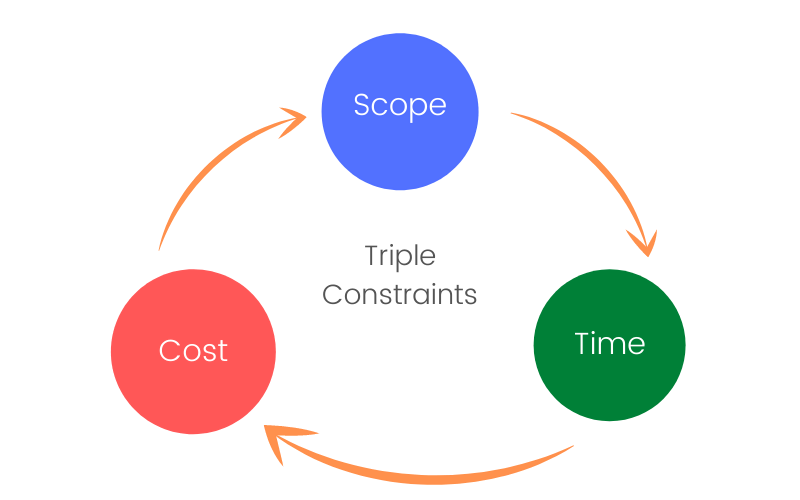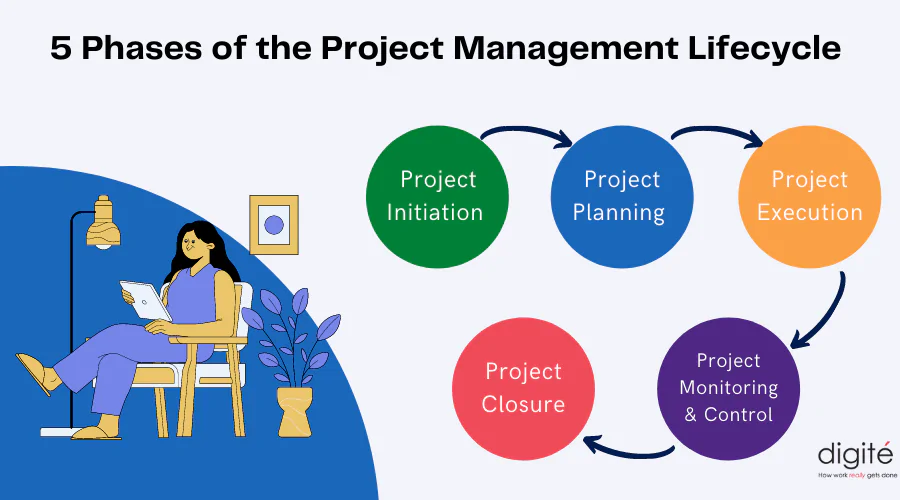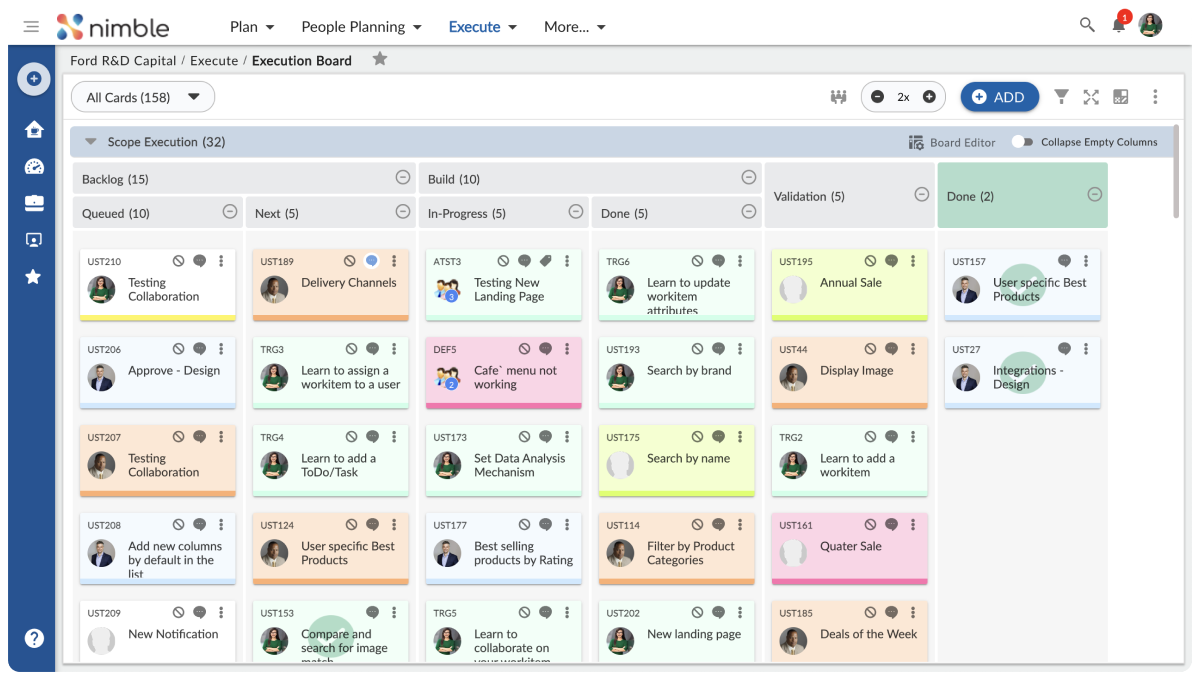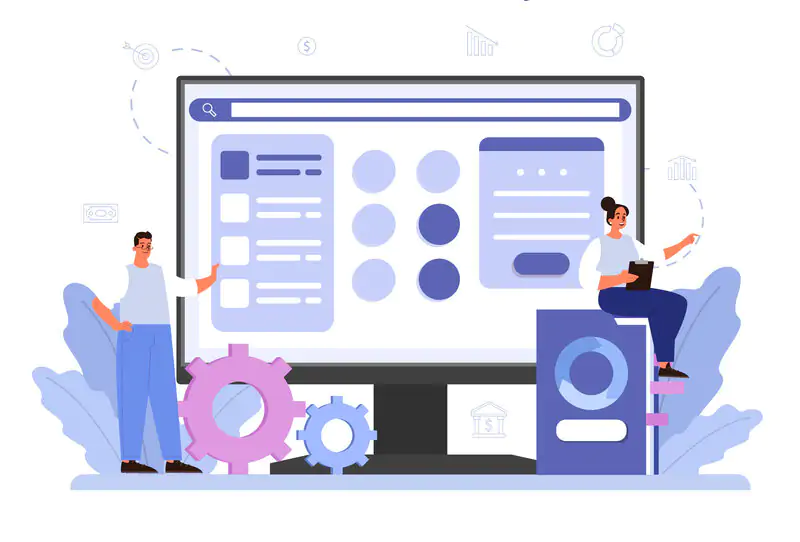What is Project Management Life Cycle? And its 5 Phases
- 11 mins read
-
By Simli Saha
- Updated on May 13, 2024
In today’s competitive global business environment, organizations need to implement the right strategies and initiatives for delivering excellence. A systematic approach to business operations is a necessity to stay ahead of the curve. Project management is the buzzword of modern business for implementing any and every new initiative in support of that.
Consequently, the discipline of project management has become more crucial than ever to organizations. A strong project management discipline starts at the portfolio level, where the strategic vision drives initial investments and where value measures are established. A fully aligned project, program, and portfolio management strategy encompasses the entire organization to meet overall company objectives.
According to a survey conducted by consulting giant McKinsey & Co., nearly 60 percent of senior executives consider building a strong project management discipline a top-three priority for their companies as they look to the future. Leading organizations across various sectors are embracing project management for greater efficiencies and organizational success. Executives discovered that adhering to project management methods and strategies reduced risks, cut costs, and improved success rates.
Implementing project management across the organization helps create a strategic value chain that gives companies an edge on their competitors. As per the Economist Intelligence Unit survey, 90% of global senior executives ranked project management methods as either critical or somewhat important to their ability to deliver successful projects and remain competitive.
As the practice of project management matures—from the portfolio level on down to individual projects—the connections between organizational project management and business value become clearer. And the more involved the executive team is, the better the results.

Project Management Overview
What is a Project?
In order to understand project management, we must first know what a project is. Everywhere you look, you are surrounded by projects. Whether it’s the construction of a building, development of a product or service, implementation of a new business process, or even smaller things such as buying a car or organizing a meeting, etc. Any such effort made to produce tangible or intangible results can be regarded as a project.
A project is defined as a one-time activity with a series of tasks that produces a specific outcome to achieve organizational goals. Projects are a set of interdependent tasks that have a common goal. No matter what the project is, each project is broken down into objectives and what needs to be done to achieve them, ensuring that the project stays on track and is completed ‘as per plan’.
There are some things to identify when considering a project, its stakeholders and characteristics that distinguishes a project from other ongoing business activities.
Projects have several characteristics-
-
Every project is unique that creates something new – or improves something existing
-
A Project is a temporary (limited time) endeavour with a definite beginning and an end
-
A Project operates within certain constraints of time, budget, scope, quality, resources and risks
-
A Project is completed when the project’s goals are achieved. A project may be canceled or discontinued if it is considered to be no longer viable. This happens quite a lot.
-
Time – the schedule for the project to reach completion
-
Cost – the budget allocated for the project to meet its objectives and complete it on time
-
Scope – the specific deliverables of the project
-
Quality – the standard of the outcome of the project
The triple constraints constituting the three most important elements namely- scope, cost, schedule are imperative for project process. They set the boundaries for the project execution process, which means that the success or failure of the project depends on meeting the constraints within acceptable tolerance limits – the deadlines, the scope, and the budget defined by the stakeholders. All three constraints are inter-connected and any change in one of them can – and usually will – affect the others.
What is Project Management?
Project Management is the set of practices involving the application of knowledge, skills, processes, methods and tools to achieve specific project requirements according to the project acceptance criteria within agreed budget and timeframe.
Project Management includes various policies and principles to lead a project from the initial stage until its completion. It involves processes to identify the requirements, create a plan to establish clear & achievable objectives, and then execute on that plan until the project goals are achieved.
Project goals and objectives provide a succinct way to communicate specific goals during the project and evaluate success after the project ends. Furthermore, every project needs a plan from start to finish that typically depicts how things will get off the ground, how they will be accomplished and completed.
Project Management Life Cycle Overview
Whether you are handling a huge conglomerate or running a small-sized enterprise, project management is an integral part of all businesses to be successful. The discipline of project management is gaining popularity and importance in all major industries.
Organizations big and small across industries are striving to deliver excellence in order to achieve a global presence. Project management is a significant part of all major project-centric industries such as construction, engineering, and IT companies, as well as others such as manufacturing, banking & finance, healthcare, pharma, NGOs, nonprofits and government.
In today’s environment, where companies are embracing mission critical initiatives in areas such as Digital Transformation, KYC, M&A, business expansion and so on, the need for managing projects effectively has become mission critical for all organizations.
As mentioned earlier, every project has a start and end and it begins with defining objectives and goals followed by a project plan to meet those objectives and executing it to accomplish final goals. To execute projects successfully – to meet its objectives, a clear understanding of the project management life cycle is essential.
The project management life cycle basically describes the high-level process of delivering a project and the steps involved to successfully deliver the project. The project management life cycle can be defined as a structured, timely and methodical process for effectively initiating, planning and executing a project for a successful outcome – which is to meet the intended objectives of the stakeholders funding the project.
Each project phase addresses a specific aspect of the process of managing a project from its conception to completion. Although these phases are described sequentially, in practice many of these phases may overlap or be applied concurrently during the lifetime of a project.
Phases of the Project Management Lifecycle
A project life cycle provides a high-level view of the project and the phases are tailored to fit a project’s needs providing a roadmap to accomplish it. The project management life cycle is divided into 5 phases: project initiation, planning, execution, monitoring & control, and closure.
As mentioned briefly earlier, projects can be executed using a “traditional methodology” such as the “Waterfall methodology” or an Agile method or a mix of the two, which is referred to by many as the “Hybrid Agile” method. Irrespective of the “execution methodology”, all projects typically go through these 5 phases from identification/ approval to completion. This article describes these phases in some detail.
1. Project Initiation
The goal of the initiation phase is to define the project at a broad level in terms of what needs to be done and achieved in order for it to be successful. This is where the stakeholders (the people or business unit who will fund the project), the goals, objectives and deliverables are identified and the resources and the money needed to do the project are determined at a high level. A high level determination is made whether the project is “feasible or not” based on these.
Key project management steps involved in the Initiation phase
-
Conduct a feasibility study to identify the primary problem the project will solve and whether the project can deliver a solution to that problem
-
Create a business case and define the project at a high level
-
Create a Project Charter or project initiation document that outlines the vision, objectives and goals of the project
-
Identify the high-level scope of the project and define the product or service the project will deliver
-
Identify key project stakeholders
-
Once the project gets a go-ahead, assemble the project team and establish a project office
A business case, a feasibility study and a Project Charter together fulfil the requirement of the Initiation phase to determine if the project is to be approved or not. Once the project is approved, one or more project initiation meetings are held to finalize the project. This is where the project initiation phase ends and the planning phase begins.
2. Project Planning
This phase begins after the project receives a green light in the Initiation phase.
The Project Planning phase is most critical and requires complete diligence as it lays out the project’s roadmap. It involves defining the work to be done and figuring out how to accomplish it. This is especially true for large and/ or complex projects, which are typically executed using traditional methodologies. Projects that are executed using Agile methods of execution also go through a planning phase, but the plans may be defined at a high level; with the detailed execution being left to the team to plan in short iterations or sprints.
The project manager begins setting goals with a project plan. A well-crafted project plan outlines a detailed project schedule, communication plan to give direction to the team for producing quality output and handling risks.
During the planning stage, the Project Manager defines the scope of the project and project management plan that involves the cost, quality, resources and project timeline. The scope is defined by the project manager with a scope statement and Work Breakdown Structure (WBS) (the deliverables for the project).
Another crucial activity during this phase is the effort and resource estimation for the project. The Project Manager, usually working with a team of experts, provides “rough order of magnitude” (ROM) estimates of all the essential elements of the project, such as effort on various phases and high level tasks, other non-labor resources and overall budgets based on that. All of these inputs go into putting together the high-level plan for the project.
Key project management steps involved in the Planning phase:
-
Create a Statement of Work document to flesh out the details of project deliverables
-
Develop a Work Breakdown Structure
-
Create a project plan, assign team members (and other resources) to the various tasks and build a detailed project timeline
-
Identify the Project Team roles and other resources for the project. At this stage, the Project Manager – working with a project staffing function – will most likely identify specific people for some of the key roles needed for the success of the project.
-
Create a risk mitigation plan to identify potential risks and develop a strategy to minimize them
-
Incorporate an effective change management plan for necessary changes in the project and to avoid bottlenecks
-
Create a communication plan to schedule interactions with relevant stakeholders
3. Project Execution
The execution phase involved actually carrying out the activities that are identified in the project plan. This is where the rubber hits the road and the project ultimately comes to reality!
This is the stage where planning is turned into action. The project team is built. Specific people and other resources are assigned to the tasks identified in the project plan. The project work is carried out in the required sequence in order to complete all of the work in the most efficient manner possible.
The key outcome of the Execution phase are the various deliverables that are produced in line with the defined project plan.
The project manager organizes the team members, establishes workflow and constantly monitors progress, ensuring that work is done as per plan, while maintaining effective collaboration between the project team and various stakeholders.
Nimble revolutionizes project management by offering a dynamic platform that centralizes all project-related activities, from task assignment and progress tracking to communication and resource allocation. Its intuitive interface and customizable features cater to the diverse needs of teams, enabling seamless collaboration and fostering a culture of transparency and accountability. With Nimble, project managers can easily identify bottlenecks, allocate resources effectively, and mitigate risks, ensuring timely delivery of high-quality results. Check out more deatils about Nimble.
Key project management steps involved in the Execution phase:
-
Identify and assign the project team Assign the team and other resources to the project tasks and begin work in the planned manner
-
Provide necessary guidance to the team on how tasks should be completed
-
Monitor progress of the team
-
Communicate with the stakeholders on a regular basis to ensure that the project deliverables are acceptable
4. Project Monitoring & Control
This phase typically runs in parallel with the Project Execution phase and involves keeping the project on track and ensuring that objectives and project deliverables are met.
The project manager reports on the performance of the project and makes sure the project is going according to plan.. This helps track any deviations from the planned budget, timeline and quality goals of the project.
Any necessary changes to the project goals are implemented after formal evaluation of the potential impact to the project goals and acceptance/ approval of the impact by the project stakeholders.
This phase also involves continuously monitoring the project environment for any risks or issues that are likely to impact the project performance, and taking the necessary steps to prevent or mitigate them as proactively as possible, to minimize impact to any of the project goals.
-
Tracking the progress of various project tasks
-
Measure budget, timeline and quality performance of the project
-
Conduct user reviews and collect feedback, and take any corrective actions needed
-
Track all changes to the project scope (whether from team members or the stakeholders) and report on their impact to project goals.
-
Monitor overall project performance, including all project plan changes, and ensure that all stakeholders and the project team are on the same page about the project status and its expected outcomes.
5. Project Closure
Project Closure is the final phase of the project management life cycle, which indicates the end of the project and the final delivery of the project deliverables.
Project Closure involves completion of the final delivery of a project and its approval by the stakeholders. Once the project’s closure is formally approved, other aspects of the closure can be carried out.
The project manager conducts a “post-project review” meeting. or commonly referred to as a retrospective- to review the lessons from the project, and the challenges that were faced during the project. It gives an opportunity to comprehend lessons learned to improve productivity in the future.
Once the above activities are completed, the project team members are released to other projects.
-
Conduct a “End of Project” Review or Retrospective and to analyze project performance and a formal analysis of successes and failures
-
Document project closure and provide reports to key stakeholders
-
Account used/ unused budget and release remaining resources for other projects
Summary
This article is an introduction to the Project Lifecycle and its key phases and activities. Projects are challenging endeavors across industries and having a good understanding of the Project Management Lifecycle is a crucial first step to executing projects successfully.
Projects come in all shapes and sizes – but always involve spending real money to do them and thus are always under scrutiny. Businesses are constantly optimizing costs and investments while trying to extract the most business benefit (RoI) on that expenditure. Running projects successfully to deliver the business value they are meant to deliver is a critical – probably the most important – aspect of that effort.
In other articles, we cover other important aspects of successful Project Management, including managing the project team, managing stakeholder expectations, change management, risk management, resource management, and many others. We will also examine what are some of the biggest challenges to running projects effectively and successfully.
Nimble offers powerful project management tools leveraging traditional and agile frameworks to plan, organize, execute and track projects.
Share the Knowledge
About Author:
Simli Saha
Agile 101
What is an Agile Epic? Benefits of Using Them
Learn what an Agile epic is, how it can streamline project management, and the benefits of incorporating epics into your Agile workflow.
Is Hybrid Agile Right for your Team? Here’s what you need to know
Explore the suitability of Hybrid Agile for your project needs in our comprehensive article. We delve into the benefits, considerations, and key factors to help you determine if this approach aligns with your organization’s goals and project requirements.
What is Hybrid Agile Project Management? A Short Guide
Discover the power of Hybrid Agile project management: achieve flexibility and structure for successful project execution. Learn how to harness this dynamic approach.
Dynamic System Development Method (DSDM)
Dynamic Systems Development Method, DSDM for short, seeks to do what came to be known as ‘Agile’ well before the manifesto was written. Learn more about its philosophy, principles, pillars, and practices.
What is Scrum Methodology? An Introduction for Agile Teams
Scrum is an agile project management framework that prioritizes collaboration and iterative development for efficient results.
Scrum of Scrums: A Starting Point to Scaling Agile
Scrum of scrums is an approach to coordinate multiple scrum teams working together. Learn how it works, how to get started and how it differs from competing approaches.
Pair programming is a programming method in which two people work together on a single program. The first person is the “Driver”, who writes the code, the other person is the “Navigator” who reviews each line of code as it is typed, checking for errors. They exchange their roles on a regular basis.
Code refactoring in Agile is a well-known technique to keep a codebase healthy and amenable to change. Learn what it is and a sound process to follow.
Ready to elevate your project management?
Experience the power of Nimble today!













